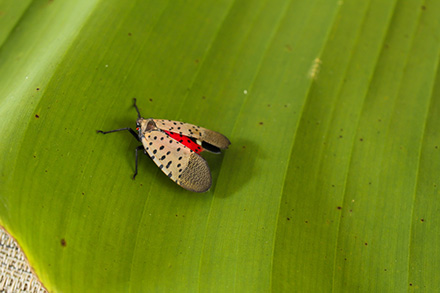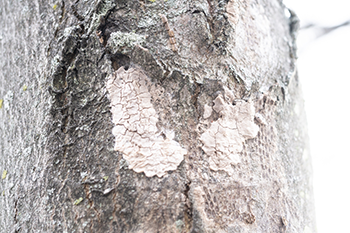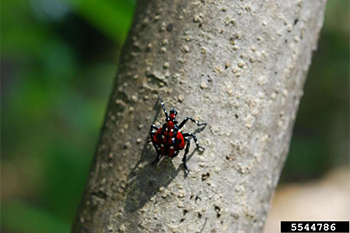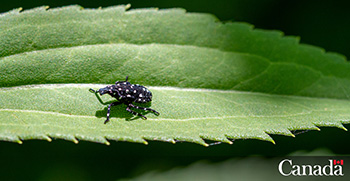PLANT PEST

Spotted lanternfly
Exotic to Australia
Features: Spotted lanternfly adults are up to 2.7 cm long and approximately 1.2 cm wide with large, visually striking wings. A hitchhiker that feeds on the sap of host plants, including economically important crops from the horticultural, forestry, ornamental and viticulture industries as well as native trees and plants.
Where it’s found: China, Korea, Japan, North America, Vietnam.
How it spreads: Hitchhikers on imported goods especially as egg masses on shipping containers, vehicles, machinery, nursery stock, fresh produce, cut flowers and foliage, wooden products and in travellers’ luggage. Once established spotted lanternfly can spread short distances by walking, jumping or flying.
At risk: More than 100 plant species from 33 families, including grapevine, apple, peach, black cherry, rose, poplar, maple, beech, and oak.
Keep it out
The spotted lanternfly is an exotic invasive planthopper. Damage causes decreases yields, impacts produce quality, reduces plant health and leads to plant mortality.
As they feed, they excrete honeydew which is attractive to other insects such as wasps, ants and bees but can also cause sooty mould, a fungal disease that inhibits a plants ability to photosynthesize and grow.
Spotted lanternfly threatens Australia’s crops grapes, apples and stone fruit, as well as nurseries. They can congregate in large numbers (1000+) and can kill trees or weaken them for attack by secondary pathogens such as sooty mould. Honeydew from feeding can also cause impacts to plants, attract wasps and bees and leave residue on outdoor furniture and buildings.
Importing goods
To keep spotted lanternfly out of Australia, never ignore Australia’s strict biosecurity rules.
Import shipments may need to be treated and certified, so before you import, check our Biosecurity Import Conditions system (BICON).
What to look for
Spotted lanternfly is most likely to enter Australia in the egg stage on smooth surfaces of containers and cargo. Look for egg masses with a grey or yellowy-brown ‘mud-like’ covering that crack over time to reveal 30–50 brown, seed-like eggs on:
- cargo ships
- commodities
- containers
- freight
- nursery stock
- plant parts
- vehicles.

Also look for adults and older nymphs gather on the branches of host plants to feed, producing large amounts of sticky, sugary waste (honeydew). Nymphs in their early stages of development appear black with white spots and turn red before becoming adults.
Lawrence Barringer, Pennsylvania Department of Agriculture, Bugwood.org

inspection.canada.ca

Where to look
Importers
To keep spotted lanternfly out of Australia, never ignore Australia’s strict biosecurity rules.
Import shipments may need to be treated and certified so before you import, check our Biosecurity Import Conditions system (BICON).
Nursery owners, growers and home gardeners
Look for egg masses, flies and nymphs as well as plant symptoms of oozing wounds on tree trunks, wilting and the death of twigs and branches, elevated insect activity or fungal growth.
What to do
If you think you’ve found spotted lanternfly:
- take a photo
- do not disturb the insect (this may be as simple as closing the doors on a shipping container or preventing access to an orchard)
- collect a sample, if it is safe to do so and if it doesn’t disturb the insects.
Read the detail
- Plant Health Australia: Spotted lanternfly fact sheet
